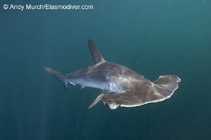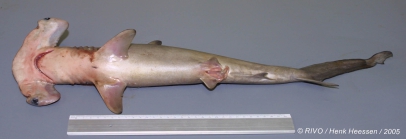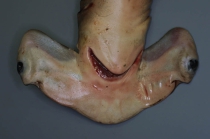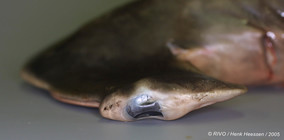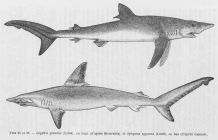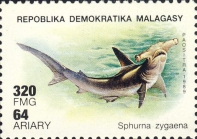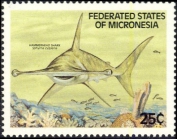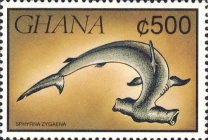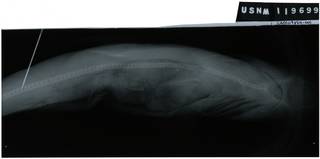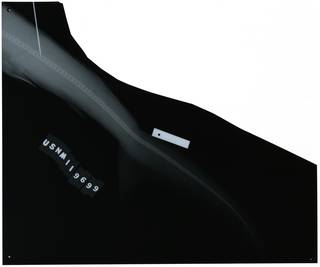WoRMS taxon details
Sphyrna zygaena (Linnaeus, 1758)
105819 (urn:lsid:marinespecies.org:taxname:105819)
accepted
Species
Sphyrna zigaena (Linnaeus, 1758) · unaccepted (misspelling)
Spyrna zygaena (Linnaeus, 1758) · unaccepted (misspelling)
Squalis pictus Blainville, 1816 · unaccepted
Squalus carolinensis Blainville, 1816 · unaccepted
Squalus malleus (Valenciennes, 1822) · unaccepted
Squalus zygaena Linnaeus, 1758 · unaccepted (synonym)
Zygaena malleus Valenciennes, 1822 · unaccepted
Zygaena subarcuata Storer, 1848 · unaccepted
Zygaena vulgaris Cloquet, 1830 · unaccepted
marine, brackish, fresh, terrestrial
(of Squalus zygaena Linnaeus, 1758) Linnaeus, C. (1758). Systema Naturae per regna tria naturae, secundum classes, ordines, genera, species, cum characteribus, differentiis, synonymis, locis. <em>Editio decima, reformata [10th revised edition], vol. 1: 824 pp. Laurentius Salvius: Holmiae.</em> , available online at https://biodiversitylibrary.org/page/726886 [details] Available for editors  [request]
[request]
Description Coastal-pelagic and semi-oceanic. Often found in shallow water over the continental and insular shelves. Enters tropical...
Distribution Southern New England to northern Argentina, straying north to Massachusetts Bay and Nova Scotia.
Description Coastal-pelagic and semi-oceanic. Often found in shallow water over the continental and insular shelves. Enters tropical waters during the winter (Ref. 9710). Feeds chiefly on fish and crustaceans but stingrays serves as a major diet in the warm waters (Ref. 2858). Juveniles live near the coasts. Fast-moving (Ref. 5213). Reported to cause poisoning (Ref. 4690). Meat utilized fresh, dried salted, and possibly smoked for human consumption, liver oil for vitamins, fins for soup, hide for leather and carcasses for fishmeal. [details]
Distribution Southern New England to northern Argentina, straying north to Massachusetts Bay and Nova Scotia.
Distribution Southern New England to northern Argentina, straying north to Massachusetts Bay and Nova Scotia. [details]
Froese, R. and D. Pauly. Editors. (2024). FishBase. Sphyrna zygaena (Linnaeus, 1758). Accessed through: World Register of Marine Species at: https://www.marinespecies.org/aphia.php?p=taxdetails&id=105819 on 2024-04-27
Date
action
by
![]() The webpage text is licensed under a Creative Commons Attribution-Noncommercial 4.0 License
The webpage text is licensed under a Creative Commons Attribution-Noncommercial 4.0 License
original description
(of Squalus zygaena Linnaeus, 1758) Linnaeus, C. (1758). Systema Naturae per regna tria naturae, secundum classes, ordines, genera, species, cum characteribus, differentiis, synonymis, locis. <em>Editio decima, reformata [10th revised edition], vol. 1: 824 pp. Laurentius Salvius: Holmiae.</em> , available online at https://biodiversitylibrary.org/page/726886 [details] Available for editors  [request]
[request]
context source (Deepsea) Intergovernmental Oceanographic Commission (IOC) of UNESCO. The Ocean Biogeographic Information System (OBIS), available online at http://www.iobis.org/ [details]
context source (HKRMS) Hong Kong marine fish database. <em>AFCD.</em> , available online at https://www.hk-fish.net/en/fish/introduction/ [details]
context source (PeRMS) Chirichigno, N.; Cornejo, M. (2001). Catálogo comentado de los peces marinos del Perú. <em>2ª ed. Instituto del Mar de Perú. Publicación Especial. Callao.</em> 314 p. [details]
basis of record van der Land, J.; Costello, M.J.; Zavodnik, D.; Santos, R.S.; Porteiro, F.M.; Bailly, N.; Eschmeyer, W.N.; Froese, R. (2001). Pisces, <B><I>in</I></B>: Costello, M.J. <i>et al.</i> (Ed.) (2001). <i>European register of marine species: a check-list of the marine species in Europe and a bibliography of guides to their identification. Collection Patrimoines Naturels,</i> 50: pp. 357-374 (look up in IMIS) [details]
additional source Collette, B. B., ; Klein-MacPhee, G. (2002). Bigelow and Schroeder's Fishes of the Gulf of Maine. <em>Smithsonian Institution Press.</em> 1-748. [details]
additional source Leim, A.H. and W.B. Scott. 1966. Fishes of the Atlantic coast of Canada. Fisheries Research Board of Canada Bulletin No. 155. 485 p. [details]
additional source Muller, Y. (2004). Faune et flore du littoral du Nord, du Pas-de-Calais et de la Belgique: inventaire. [Coastal fauna and flora of the Nord, Pas-de-Calais and Belgium: inventory]. <em>Commission Régionale de Biologie Région Nord Pas-de-Calais: France.</em> 307 pp., available online at http://www.vliz.be/imisdocs/publications/145561.pdf [details]
additional source King, C.M.; Roberts, C.D.; Bell, B.D.; Fordyce, R.E.; Nicoll, R.S.; Worthy, T.H.; Paulin, C.D.; Hitchmough, R.A.; Keyes, I.W.; Baker, A.N.; Stewart, A.L.; Hiller, N.; McDowall, R.M.; Holdaway, R.N.; McPhee, R.P.; Schwarzhans, W.W.; Tennyson, A.J.D.; Rust, S.; Macadie, I. (2009). Phylum Chordata: lancelets, fishes, amphibians, reptiles, birds, mammals. <em>in: Gordon, D.P. (Ed.) (2009). New Zealand inventory of biodiversity: 1. Kingdom Animalia: Radiata, Lophotrochozoa, Deuterostomia.</em> pp. 431-554. [details]
additional source Liu, J.Y. [Ruiyu] (ed.). (2008). Checklist of marine biota of China seas. <em>China Science Press.</em> 1267 pp. (look up in IMIS) [details] Available for editors [request]
[request]
additional source Linnaeus, C. (1758). Systema Naturae per regna tria naturae, secundum classes, ordines, genera, species, cum characteribus, differentiis, synonymis, locis. <em>Editio decima, reformata [10th revised edition], vol. 1: 824 pp. Laurentius Salvius: Holmiae.</em> , available online at https://biodiversitylibrary.org/page/726886
page(s): 234 [details] Available for editors [request]
[request]
additional source Wheeler, A. (1992). A list of the common and scientific names of fishes of the British Isles. <i>J. Fish Biol. 41(Suppl. A)</i>: 1-37 (look up in IMIS)
page(s): 234 [details]
additional source Froese, R. & D. Pauly (Editors). (2023). FishBase. World Wide Web electronic publication. version (02/2023)., available online at https://www.fishbase.org [details]
context source (Deepsea) Intergovernmental Oceanographic Commission (IOC) of UNESCO. The Ocean Biogeographic Information System (OBIS), available online at http://www.iobis.org/ [details]
context source (HKRMS) Hong Kong marine fish database. <em>AFCD.</em> , available online at https://www.hk-fish.net/en/fish/introduction/ [details]
context source (PeRMS) Chirichigno, N.; Cornejo, M. (2001). Catálogo comentado de los peces marinos del Perú. <em>2ª ed. Instituto del Mar de Perú. Publicación Especial. Callao.</em> 314 p. [details]
basis of record van der Land, J.; Costello, M.J.; Zavodnik, D.; Santos, R.S.; Porteiro, F.M.; Bailly, N.; Eschmeyer, W.N.; Froese, R. (2001). Pisces, <B><I>in</I></B>: Costello, M.J. <i>et al.</i> (Ed.) (2001). <i>European register of marine species: a check-list of the marine species in Europe and a bibliography of guides to their identification. Collection Patrimoines Naturels,</i> 50: pp. 357-374 (look up in IMIS) [details]
additional source Collette, B. B., ; Klein-MacPhee, G. (2002). Bigelow and Schroeder's Fishes of the Gulf of Maine. <em>Smithsonian Institution Press.</em> 1-748. [details]
additional source Leim, A.H. and W.B. Scott. 1966. Fishes of the Atlantic coast of Canada. Fisheries Research Board of Canada Bulletin No. 155. 485 p. [details]
additional source Muller, Y. (2004). Faune et flore du littoral du Nord, du Pas-de-Calais et de la Belgique: inventaire. [Coastal fauna and flora of the Nord, Pas-de-Calais and Belgium: inventory]. <em>Commission Régionale de Biologie Région Nord Pas-de-Calais: France.</em> 307 pp., available online at http://www.vliz.be/imisdocs/publications/145561.pdf [details]
additional source King, C.M.; Roberts, C.D.; Bell, B.D.; Fordyce, R.E.; Nicoll, R.S.; Worthy, T.H.; Paulin, C.D.; Hitchmough, R.A.; Keyes, I.W.; Baker, A.N.; Stewart, A.L.; Hiller, N.; McDowall, R.M.; Holdaway, R.N.; McPhee, R.P.; Schwarzhans, W.W.; Tennyson, A.J.D.; Rust, S.; Macadie, I. (2009). Phylum Chordata: lancelets, fishes, amphibians, reptiles, birds, mammals. <em>in: Gordon, D.P. (Ed.) (2009). New Zealand inventory of biodiversity: 1. Kingdom Animalia: Radiata, Lophotrochozoa, Deuterostomia.</em> pp. 431-554. [details]
additional source Liu, J.Y. [Ruiyu] (ed.). (2008). Checklist of marine biota of China seas. <em>China Science Press.</em> 1267 pp. (look up in IMIS) [details] Available for editors
additional source Linnaeus, C. (1758). Systema Naturae per regna tria naturae, secundum classes, ordines, genera, species, cum characteribus, differentiis, synonymis, locis. <em>Editio decima, reformata [10th revised edition], vol. 1: 824 pp. Laurentius Salvius: Holmiae.</em> , available online at https://biodiversitylibrary.org/page/726886
page(s): 234 [details] Available for editors
additional source Wheeler, A. (1992). A list of the common and scientific names of fishes of the British Isles. <i>J. Fish Biol. 41(Suppl. A)</i>: 1-37 (look up in IMIS)
page(s): 234 [details]
additional source Froese, R. & D. Pauly (Editors). (2023). FishBase. World Wide Web electronic publication. version (02/2023)., available online at https://www.fishbase.org [details]
 Present
Present  Present in aphia/obis/gbif/idigbio
Present in aphia/obis/gbif/idigbio  Inaccurate
Inaccurate  Introduced: alien
Introduced: alien  Containing type locality
Containing type locality
From other sources
Description Coastal-pelagic and semi-oceanic. Often found in shallow water over the continental and insular shelves. Enters tropical waters during the winter (Ref. 9710). Feeds chiefly on fish and crustaceans but stingrays serves as a major diet in the warm waters (Ref. 2858). Juveniles live near the coasts. Fast-moving (Ref. 5213). Reported to cause poisoning (Ref. 4690). Meat utilized fresh, dried salted, and possibly smoked for human consumption, liver oil for vitamins, fins for soup, hide for leather and carcasses for fishmeal. [details]Distribution Southern New England to northern Argentina, straying north to Massachusetts Bay and Nova Scotia. [details]
Habitat nektonic [details]
Habitat found in shallow coastal waters; enters bays [details]
Importance Social- Commercial, gamefish; danger to divers and swimmers [details]
Predators Unknown [details]
Reproduction Viviparous, litter size of 20-40 pups [details]
| Language | Name | |
|---|---|---|
| Albanian | peshku çekiçpeshku çekanpeshk karabinier | [details] |
| Danish | hammerhaj | [details] |
| Dutch | hamerhaai | [details] |
| English | smooth hammerheadshovelhead sharkhammerhead sharkhammerhead | [details] |
| French | requin marteau | [details] |
| German | Hamerhaiglatter Hammerhai | [details] |
| Hebrew | פטישן תמים-חרטום | [details] |
| Italian | pesce martello | [details] |
| Japanese | シロシュモクザメ | [details] |
| Lithuanian | paprastasis kūjaryklis | [details] |
| Modern Greek (1453-) | Ζύγαινα | [details] |
| Polish | ryba młotrekin młotgłowomłot pospolity | [details] |
| Portuguese | cornuda | [details] |
| Russian | обыкновенная акула-молот | [details] |
| Slovenian | kladvenica | [details] |
| Spanish | tiburón martillo cruzpez martillocornuda prietacornuda cruz | [details] |
| Turkish | çekiç köpekbalığıcekic kopekbaligiçekiç balığıcekic baligi | [details] |
| Ukrainian | риба-молотЗвичайна акула-молотАкула-молот звичайна | [details] |
| Welsh | morgi pen morthwyl | [details] |
To Barcode of Life (182 barcodes)
To Biodiversity Heritage Library (1 publication) (from synonym Spyrna zygaena (Linnaeus, 1758))
To Biodiversity Heritage Library (19 publications) (from synonym Squalus malleus (Valenciennes, 1822))
To Biodiversity Heritage Library (2 publications) (from synonym Squalus carolinensis Blainville, 1816)
To Biodiversity Heritage Library (217 publications)
To Biodiversity Heritage Library (243 publications) (from synonym Zygaena malleus Valenciennes, 1822)
To Biodiversity Heritage Library (3 publications) (from synonym Sphyrna zigaena (Linnaeus, 1758))
To Biodiversity Heritage Library (4 publications) (from synonym Zygaena vulgaris Cloquet, 1830)
To Biodiversity Heritage Library (44 publications) (from synonym Squalus zygaena Linnaeus, 1758)
To Biodiversity Heritage Library (9 publications) (from synonym Zygaena subarcuata Storer, 1848)
To Biological Information System for Marine Life (BISMaL) (from synonym Squalus zygaena Linnaeus, 1758)
To Biological Information System for Marine Life (BISMaL)
To European Nucleotide Archive (ENA)
To FishBase (from synonym Squalus zygaena Linnaeus, 1758)
To FishBase (from synonym Squalus malleus (Valenciennes, 1822))
To FishBase
To FishBase (from synonym Zygaena vulgaris Cloquet, 1830)
To FishBase (from synonym Sphyrna zigaena (Linnaeus, 1758))
To FishBase (from synonym Zygaena subarcuata Storer, 1848)
To FishBase (from synonym Squalis pictus Blainville, 1816)
To FishBase (from synonym Zygaena malleus Valenciennes, 1822)
To FishBase (from synonym Spyrna zygaena (Linnaeus, 1758))
To FishBase (from synonym Squalus carolinensis Blainville, 1816)
To FishBase images (Sphyrna zygaena, by Murch, A.)
To GenBank (326 nucleotides; 309 proteins) (from synonym Squalus zygaena Linnaeus, 1758)
To GenBank (326 nucleotides; 309 proteins)
To Global Biotic Interactions (GloBI)
To IUCN Red List (Vulnerable)
To NMNH Extant Collection (Sphyrna zygaena RAD109854-001)
To PESI
To ITIS
To Biodiversity Heritage Library (1 publication) (from synonym Spyrna zygaena (Linnaeus, 1758))
To Biodiversity Heritage Library (19 publications) (from synonym Squalus malleus (Valenciennes, 1822))
To Biodiversity Heritage Library (2 publications) (from synonym Squalus carolinensis Blainville, 1816)
To Biodiversity Heritage Library (217 publications)
To Biodiversity Heritage Library (243 publications) (from synonym Zygaena malleus Valenciennes, 1822)
To Biodiversity Heritage Library (3 publications) (from synonym Sphyrna zigaena (Linnaeus, 1758))
To Biodiversity Heritage Library (4 publications) (from synonym Zygaena vulgaris Cloquet, 1830)
To Biodiversity Heritage Library (44 publications) (from synonym Squalus zygaena Linnaeus, 1758)
To Biodiversity Heritage Library (9 publications) (from synonym Zygaena subarcuata Storer, 1848)
To Biological Information System for Marine Life (BISMaL) (from synonym Squalus zygaena Linnaeus, 1758)
To Biological Information System for Marine Life (BISMaL)
To European Nucleotide Archive (ENA)
To FishBase (from synonym Squalus zygaena Linnaeus, 1758)
To FishBase (from synonym Squalus malleus (Valenciennes, 1822))
To FishBase
To FishBase (from synonym Zygaena vulgaris Cloquet, 1830)
To FishBase (from synonym Sphyrna zigaena (Linnaeus, 1758))
To FishBase (from synonym Zygaena subarcuata Storer, 1848)
To FishBase (from synonym Squalis pictus Blainville, 1816)
To FishBase (from synonym Zygaena malleus Valenciennes, 1822)
To FishBase (from synonym Spyrna zygaena (Linnaeus, 1758))
To FishBase (from synonym Squalus carolinensis Blainville, 1816)
To FishBase images (Sphyrna zygaena, by Murch, A.)
To GenBank (326 nucleotides; 309 proteins) (from synonym Squalus zygaena Linnaeus, 1758)
To GenBank (326 nucleotides; 309 proteins)
To Global Biotic Interactions (GloBI)
To IUCN Red List (Vulnerable)
To NMNH Extant Collection (Sphyrna zygaena RAD109854-001)
To PESI
To ITIS
